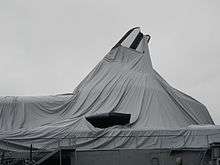Effects of Hurricane Sandy in New York
| Category 1 hurricane (SSHWS/NWS) | |
.jpg) Satellite image of Sandy near landfall | |
| Winds |
1-minute sustained: 80 mph (130 km/h) Gusts: 100 mph (155 km/h) |
|---|---|
| Fatalities | 53 total |
| Damage |
$32 billion (2012 USD) (Estimated damage total) |
| Areas affected | New York, especially the New York metropolitan area[1] |
| Part of the 2012 Atlantic hurricane season | |
|
Impact Other wikis | |
New York was severely affected by Hurricane Sandy in 2012, particularly New York City, its suburbs, and Long Island. Sandy's impacts included the flooding of the New York City Subway system, of many suburban communities, and of all road tunnels entering Manhattan except the Lincoln Tunnel. The New York Stock Exchange closed for two consecutive days. Numerous homes and businesses were destroyed by fire, including over 100 homes in Breezy Point, Queens. Large parts of the city and surrounding areas lost electricity for several days. Several thousand people in midtown Manhattan were evacuated for six days due to a crane collapse at Extell's One57. Bellevue Hospital Center and a few other large hospitals were closed and evacuated. Flooding at 140 West Street and another exchange disrupted voice and data communication in lower Manhattan.[2]
At least 53 people died in New York as a result of the storm. Thousands of homes and an estimated 250,000 vehicles were destroyed during the storm, and the economic losses in New York City were estimated to be roughly $19 billion[3] with an estimated $32.8 billion required for restoration across the state.[4]
Preparations
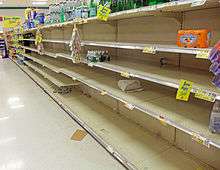

On October 28, New York Governor Andrew Cuomo declared a state of emergency for every county in the state. He also asked for a pre-disaster declaration to better access federal assistance.[5] Nassau County Executive Ed Mangano ordered voluntary evacuations of the South Shore storm surge area, which includes the area south of Sunrise Highway, as well as the North Shore's areas north of Route 25A and in elevations 15 feet above sea level or less.[6] Shelters were opened at Levittown Memorial High School, Locust Valley High School, Nassau Community College and SUNY Old Westbury. In Suffolk County, officials ordered mandatory evacuations for residents of Fire Island and in surge zone areas in Babylon, Brookhaven, Islip, Riverhead, Southampton and Southold. Shelters were opened at Hampton Bays High School, Sachem East High School, and the Brentwood High School Sonderling Building.[7] Most schools closed in Nassau and Suffolk counties on October 29, including Adelphi University, Hofstra University, Molloy College, Nassau Community College and Stony Brook University.[8][9]
On October 28, President Barack Obama signed an emergency declaration for the state of New York.[10] The Metro-North Railroad and the Long Island Rail Road suspended service beginning 7 p.m. October 27 through October 29 and possibly October 30.[11] Starbucks closed all of its outlets in the city and Long Island on October 28 at 4 p.m. to let employees get home before the transit system shut down. The stores remained closed on October 29.[12] The Tappan Zee Bridge was closed October 29 at 4 p.m. EDT due to wind conditions.[13]
Bloomberg told reporters on October 26 that the city had begun taking precautions but said at that time there was no call for mandatory evacuations and no plans to suspend the city's mass transit or cancel school. But on October 28, Governor Cuomo ordered the MTA, including the subway, closed and in a press conference immediately after Cuomo's announcement, Mayor Bloomberg ordered public schools closed on October 29.[14] He ordered mandatory evacuations for Zone A[15] which includes the southern tip of Manhattan, the Coney Island-Brighton Beach and Red Hook areas of Brooklyn, the entire Rockaways peninsula, much of Staten Island, City Island, and part of the Throggs Neck area of the Bronx.[16] On October 28, officials activated the city's coastal emergency plan, with subway closings and the evacuation of residents in areas hit during Hurricane Irene in August 2011. More than 76 evacuation shelters were open around the city.[5]
The MTA announced that all subway, bus and commuter rail service would be suspended, beginning at 7 p.m. EDT on October 28 and expected to continue suspension through at least October 30.[17] All PATH train service and stations were shut down at 12:01 a.m. October 29.[14] 200 National Guard troops were deployed in the city. All bus carriers at the Port Authority Bus Terminal closed at 3 a.m. October 29. U.S. stock trading was suspended for October 29 and October 30.[18] It was the first two-day weather closure since the Great Blizzard of 1888.[19] All state courts were closed October 29, except for arraignments and emergency applications. NYU Langone Medical Center cancelled all surgeries and medical procedures, except for emergency procedures.[20]
On October 27, Google postponed their planned Android event in New York City due to the storm.[21][22] The Staten Island Ferry and East River Ferry services were suspended at least through October 29.[23] Most bridges and tunnels closed. Major carriers cancelled all flights into and out of JFK, LaGuardia and Newark-Liberty airports until it was safe to fly. Broadway cancelled all October 28 evening and October 29 performances.[11] Alternate-side parking and parking meter regulations were suspended on October 29.[24] Grand Central Terminal, Central Park and Battery Park were closed on October 29. The Holland Tunnel and the Brooklyn–Battery Tunnel closed at 2 p.m. EDT on October 29. The Tappan Zee Bridge was closed later on that day.[25][26]
One of the units at Indian Point nuclear power plant (Unit #3) was shut down around 10:45 p.m. October 29, because of external electrical grid issues according to plant operator Entergy.[27]
Immediate aftermath

While moving ashore in New Jersey, the northern and eastern sides of Sandy were characterized with light, sporadic rainfall, but strong winds. Precipitation in New York reached 3.42 in (87 mm) in Sherman, in the extreme western portion of the state. The highest recorded wind gust in New York was 90 miles per hour (140 km/h) at Islip.[28] Supplemented by spring tide, the storm surge was approximately 14 feet above Mean Low Water,[29] flooding many tunnels and damaging electrical equipment. The 1821 Norfolk and Long Island Hurricane was similarly powerful but struck at low tide and thus caused less flooding.
United States Secretary of Health and Human Services Kathleen Sebelius declared a public health emergency on October 31 for New York.[30] In response, the Federal Emergency Management Agency (FEMA) sent 30 teams of workers into damaged areas of the New York region.[32]
During a news conference on November 1, Mayor Bloomberg announced that most parks would reopen on November 3; that Coney Island, the Rockaways, and parts of Staten Island would get temporary centers for the distribution of meals and bottles of water at a time; that AT&T would bring cellphone-charging and cell service-enabled pods to certain areas of New York City; and that 400 members of the National Guard were to go door-to-door to deliver meals and supplies to elderly and home-bound residents.[29] A relief fund was created for residents of Staten Island. Time Warner Cable donated $500,000 to the Mayor's Fund to Advance New York City, and $50,000 each to the Red Cross of Northeastern New York and the Red Cross of Northern New Jersey. They also sent out vehicles with mobile charging stations and free WiFi access points, and additionally opened all of their WiFi spots in the city.[31]

United States Secretary of Homeland Security Janet Napolitano toured the island on November 2.[30]On that same day, the state of New York created a $100 million fund to help people hit hardest.[33]
On November 3, the National September 11 Memorial & Museum was being pumped free of floodwater and reopened on the 6th.[34] Five emergency mobile gas stations were deployed by the military on the same day, offering 10 free gallons per person.[35]
Thousands of runners who came to the city to run the New York City Marathon met in Central Park on November 4; due to the marathon's being called off, many went to Staten Island to help storm victims.[36]
On November 5, meteorologists began tracking a coastal nor'easter that threatened cleanup and recovery efforts in the state on November 7 and 8.[37] NYU Langone Medical Center, evacuated during the storm, began reopening on the same day,[38] and about 750 workers resumed construction on Ground Zero.[39]Governor Cuomo signed an executive order saying that displaced New Yorkers could vote in the 2012 United States elections at any polling place in the state.[40]
On November 7, Governor Cuomo fired Steven Kuhr, the head of the New York Office of Emergency Management, after Cuomo discovered that Kuhr had sent Suffolk County workers to clear a tree in his Long Island driveway as other victims needed help.[41] A day later, Cuomo said that the estimated storm damage in New York state was $33 billion.[1] New York City and the counties of Nassau and Suffolk imposed "odd-even" gasoline rationing, as New Jersey had, to ease congestion and frustration at filling stations. The system began on November 9 in the wake of a shortage.[42] Cuomo also temporarily waived certain taxes and pollution restrictions on fuel deliveries.[43]
Venue closures
New York City schools remained closed through Friday, November 2 with classes resuming Monday for most students; but as many as 40,000 stayed home until November 7. 57 schools were still flooded as of that date.[31] Many colleges and universities and k-12 schools in the tri-state area also cancelled classes.[32][33][34]
The Statue of Liberty was closed October 29, a day after its grand reopening. Both the statue and Ellis Island remained closed through 2012;[35] the statue reopened July 4, 2013,[36] while Ellis Island remained closed until 2014.[37]
The New York State Office of Parks, Recreation and Historic Preservation closed all state parks on Long Island until further notice, due to downed trees, dangling branches, beach erosion, and damaged boardwalks.[38]
On November 1, CBS News reported the 76 shelters opened initially were being consolidated down to 15.[39]
On November 6, Bloomberg announced the closing of parks, playgrounds and beaches again for 24 hours starting at noon November 7, as the nor'easter neared.[40] Also on November 6, John Jay High School in Brooklyn, being used as a shelter for Sandy victims, was shut down after about a dozen storm refugees came down with a stomach virus. Bloomberg said the school would be closed November 7 instead of opening for classes as scheduled, so it could be cleaned and then reopened.[41]
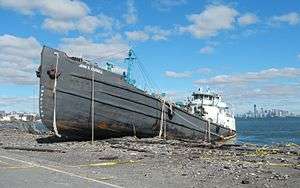
Transportation
Waterways and services
On October 30, the John B. Caddell tanker was driven ashore at Staten Island.[42]
On October 31, NY Waterway ferries between Hudson County, New Jersey, and Manhattan resumed service. The Staten Island Ferry resumed full service November 2 and Staten Island Railway the next day.
On November 1, fuel ships started arriving in reopened New York Harbor.[43]
On November 2, Governor Cuomo signed an executive order waiving the state's requirements that fuel tankers register and pay a tax before unloading.[44]
Ground


The George Washington Bridge, Throgs Neck Bridge, Verrazano Bridge, and Whitestone Bridge closed at 7 p.m. EDT October 29. All road tunnels into Manhattan, except the Lincoln Tunnel, were flooded and closed, as were subway tunnels under the East River and the PATH subway system.[45] Limited bus service resumed Tuesday evening, Oct 30. Limited MTA subway service was scheduled to resume on November 1 with two East River tunnels (59th Street and 63rd Street) in operation and shuttle bus service to Manhattan from Brooklyn termini.[46] The Long Island Rail Road remained closed due to storm damage until November 8, 2012. The LIRR then re-opened with partial service to most of its branches, excluding Long Beach.[47] Nassau Inter-County Express and Suffolk County Transit suspended and/or greatly limited service for the storm.[48] In response to the flooding of tunnels and other infrastructure, the United States Army Corps of Engineers sent its National Unwatering Team.[49]
As of October 31, 2012, MTA bus service began operating on a regular schedule. The subway system was tested with plans to resume limited service to 14 of the 23 services on November 1. PATH services remained suspended; the Long Island Rail Road resumed limited, hourly service; and Metro-North restored hourly service on its Harlem Line between North White Plains and Grand Central Terminal. All bridges and tunnels were open except the Hugh L. Carey Tunnel. Amtrak provided modified service starting on November 1, and the Port Authority Bus Terminal reopened with no Greyhound Lines service or commuter buses to New Jersey.[50]
On the morning of November 1, the first train, an A train, pulled out of Penn Station three days after tunnels were flooded. Subway service in Lower Manhattan except for the IRT Lexington Avenue Line and to Brooklyn was disconnected. The G train (which is a crosstown route between Queens and Brooklyn), as well as the Rockaway Park Shuttle and the part-time B, C, and Z trains, were also suspended.[51][52] Governor Cuomo waived fares on MTA trains and buses through November 5.[53]
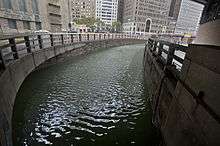
The Holland Tunnel opened to buses only on November 2.[54] HOV restrictions on bridges and Lincoln Tunnel ended on that day. By November 3, 80 percent of subway service was restored.[55] On November 6, the Queens Midtown Tunnel reopened one lane for buses heading into and out of Manhattan during rush hour.[56] The Holland Tunnel reopened November 7 at 5 a.m. EST.,[57] while the Queens-Midtown Tunnel reopened on November 9 at 6 a.m. EST.[58] The Hugh L. Carey Tunnel opened November 12 to limited rush-hour bus service.[59]
Airports and airlines
Delta Air Lines cancelled all flights out of LaGuardia Airport through October 30 at 8 p.m. EDT.[60] The three major airports serving New York City, JFK, LaGuardia, and Newark, were closed as of 8 p.m. on October 29.[61] More than 8,000 flights were canceled by 4 p.m. EDT for the day of October 30. LaGuardia and Newark had a total of 2,400 cancelled flights. As of early morning October 31, nearly 3,000 flights were canceled,[62] but JFK and Newark airports began handling flights after 7 a.m.[50] LaGuardia Airport reopened November 1 at 7:00 a.m.[50]
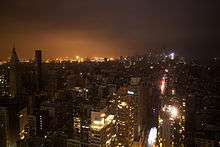
Events
New York's Village Halloween Parade, held annually on October 31, was cancelled due to blackout conditions in Greenwich Village.[63]
After many complaints that running the race through affected areas would seem insensitive and would put further pressure on police and other service workers who would be better deployed in the recovery efforts, Mayor Bloomberg announced late afternoon November 2 that the New York City Marathon had been cancelled. The event was to take place on Sunday, November 4. Marathon officials said that it will not be rescheduled.[64]
The opening game at the Barclays Center between the National Basketball Association's Brooklyn Nets and New York Knicks originally scheduled to take place on November 1 was rescheduled for November 26.[65]
The soccer game between the New York Red Bulls and D.C. United in the 2012 Major League Soccer playoffs, scheduled for November 3, was moved to November 7, due to a power outage at Red Bull Arena in New Jersey.
Evacuations and rescues during storm
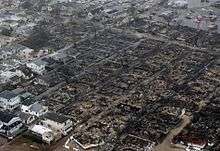
New York University Langone Medical Center was evacuated October 29 after the backup generators at the hospital failed due to flooding. Over 200 patients were safely transferred to other hospitals.[66] Bellevue Hospital Center (about 500 patients), Coney Island Hospital, and Palisades Medical Center are additional New York City area hospitals which have been either partially or fully evacuated.[67][68]
The Emergency Medical Services of New York City faced a series of challenges and setbacks during the storm relating to the flooding, closure, and evacuation of hospitals and FDNY-EMS Stations across the city. Downtown Hospital was closed in preparation for the storm, but several hospitals were forced to close during the storm, including Bellevue Hospital, NYU Hospital, Manhattan VA Hospital, Metropolitan Hospital, Coney Island Hospital, and St. Johns Hospital. A fire broke out on the fourth floor of Coney Island Hospital, which proved difficult for Fire and EMS resources access due to flooding, high winds, and downed wires. Four out of five FDNY-EMS Stations in Manhattan were evacuated during the storm as flooding began to surround stations in low-lying areas, including EMS Station 4 (South Street, location of Division 1 Headquarters which was moved to Downtown Brooklyn during the storm), Station 7 (Chelsea), Station 8 (Bellevue), and Station 10 (Spanish Harlem/Metropolitan Hospital). Station 16, located at Harlem Hospital, did not have to evacuate.
On October 29, National Guard troops arrived in Island Park, New York, as anecdotal accounts and earlier reports of a substation explosion were officially denied by a LIPA representative.[69]
On October 30, a helicopter rescue crew airlifted five adults and a child from the roof of a Staten Island house which was nearly submerged by flooding waters.[70]
On October 31, National Guard troops and local police were evacuating the last of 700 patients from Bellevue to other hospitals and local shelters.[71]
On November 6, some of the state's residents that had been evacuated for Sandy were evacuated a second time due to a nor'easter that was expected to bring high winds, rain and possible snow to areas of New York.[72]
Damage


On November 26, Governor Cuomo said Sandy cost the state $32 billion in damage and loss. Mayor Bloomberg announced earlier in the day that the storm caused $19 billion in losses in New York City, which was included in the estimate Cuomo gave.[73] At the time of the disaster, a total of 43 civilians were confirmed to have died in New York City as a result of the hurricane.[3]
Electricity
As of the morning of November 1, Con Ed had restored two power networks, but there were still more than 600,000 customers without power throughout the five boroughs. Con Ed predicted most all of Manhattan would be fully restored by November 3.[74] By the afternoon of the same day, Con Ed said it expected to "restore the vast majority of customers who lost power by the weekend of November 10 and 11. The remaining customer restorations could take an additional week more."[39]
As of the morning of November 2, more than 1.3 million customers were without power, down from 2.2 million. As of 5:00 a.m. EDT (0900 GMT) on that date Con Edison said about 226,000 customers lacked service in Manhattan, 84,000 in Queens, 35,000 in Brooklyn, 54,000 in Staten Island 31,000 in the Bronx and 140,000 in Westchester. On Long Island, LIPA said it still had about 532,000 customers without power, down from more than 900,000.[75] In the evening of November 2, LIPA said they expected to cut the number of customer outages by 150,000 by November 4.[76]
As of 4 a.m. November 3, Con Ed reported about:
- 94,769 customer outages in Manhattan
- 81,372 customer outages in Queens
- 37,504 customer outages in Staten Island
- 31,448 customer outages in Brooklyn
- 26,252 customer outages in the Bronx[77]
During the evening of November 3, Con Ed announced all Manhattan power networks were back online. Approximately 153,000 Con Ed customers were without power as of 8 p.m. November 3:
- 9,211 customer outages in Manhattan
- 74,067 customer outages in Queens
- 27,842 customer outages in Staten Island
- 24,707 customer outages in Brooklyn
- 19,501 customer outages in the Bronx[78]
As of around noon November 5, Con Ed reported those without electricity were:
- 3,825 customer outages in Manhattan
- 38,397 customer outages in Queens
- 17,465 customer outages in Staten Island
- 22,887 customer outages in Brooklyn
- 8,282 customer outages in the Bronx[79]
As of January 2013, there were still 8,200 people without power.[80]
Fires
On October 30, over 190 firefighters fought a six alarm fire that destroyed 111 structures and damaged another 20 in Breezy Point, Queens, as a result of the storm. The area had been under evacuation orders, but some residents rode out the storm. One firefighter and two residents were injured. The rescuers were in chest-deep water and had to use a boat to reach survivors. A transformer explosion is suspected to have caused the fire.[100] On October 31, Breezy Point residents pledged to rebuild their community.[101]
Suffolk county suffered an outbreak of fires in the aftermath of the storm with ten separate instances occurring at once as a result of downed trees collapsing on power lines and exploding transformers. Compounded with the floodwaters, the situation taxed first responders heavily, leading to instances where firefighters became trapped due to rising waters as they were working to save affected residents.[89]One home in West Babylon and another in Lindenhurst were burning continuously, and both had to be knocked down with payloaders.[89]
Wind
Heavy winds caused a construction crane atop One57 to collapse, causing the area to be evacuated on October 29.[81] The crane was secured to the building on November 3 and West 57th Street reopened to traffic that evening.[82]
Space Shuttle Enterprise, on board the flight deck of the Intrepid Sea, Air & Space Museum in the Hudson River, was damaged. The shuttle's inflatable structure appears to have first deflated and then been torn by the high winds.[83]
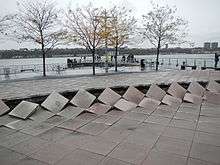
Structures
The storm damaged, destroyed, or severely flooded around 100,000 homes on Long Island. As of December 10, 2012, more than 2,000 homes were deemed uninhabitable.[84]
Bloomberg stated on November 3 that there were 55,000 buildings in Zone A that were ordered to evacuate and must be inspected.[85]
Damaged structures included community centers in South Brooklyn. The offices of the Jewish Community Council of Greater Coney Island, as well as a senior home run by the organization, were affected.[86][87] The Old Orchard Shoal Light in New York Harbor was destroyed by the hurricane.[88][89]
Political
The hurricane damaged many homes beyond habitability. Governor Cuomo worked closely with President Barack Obama and with Governor Chris Christie of New Jersey, which was even more hard-hit, to come to their aid. Cuomo allowed New York voters, via a specific provision aimed at accommodating those displaced, to cast provisional ballots for the 2012 election anywhere in New York state.[90] He also appointed a commission to examine the responses of New York utilities to damage caused by the storm, and to help lower the energy costs of residents affected by the damage. The Cuomo administration used $140 million of the funds originally allocated to this commission in order to pay for the broadcast of national TV ads encouraging businesses to return to New York after the disaster.[81][82] Many have been critical of the effort, including former New York governor Eliot Spitzer, who called the ads "fluff" and "a waste of taxpayer money".[81][82]
Looting
Looters and burglars were arrested in Coney Island, the Rockaways, and other parts of New York City and Long Island which had been evacuated or damaged by the storm.[91] Some posed as Con Ed workers to fool their victims;[92] some other, would-be-looters posed as rescue workers.[93] On November 2, it was reported that "on Long Island, looting has become such a problem on the south shore in the wake of superstorm Sandy that state police are on patrol."[94] In addition to the looting of homes and stores, armed robberies, criminal siphoning of gasoline out of vehicle gas tanks, and thefts of generators were reported. Some New Yorkers ignored advice to evacuate in advance of the nor'easter of November 7–, in favor of protecting their property.[95][96] Thefts were averted by residents, some armed, who surprised those who had broken into their homes; by the National Guard; and by neighborhood watch groups.[97][98]
On November 1, a St. Albans motorist was arrested on charges of menacing and criminal possession of a weapon after he tried to cut in line at a Mobil station on the corner of Astoria Boulevard and 43rd Street in Queens and pointed a pistol at another motorist who complained.[99][100][101] Also, in Brooklyn, people argued at a Getty gas station. It was further reported that gasoline, in heavy demand for both vehicles and home generators, had become scarce and frustration with fuel supplies topped "the list of issues causing tensions to boil over in New Jersey, New York and Connecticut, the states hardest hit by power outages in the wake of superstorm Sandy."[100] As of November 6, police reported 41 arrests in New York City stemming from fights at gas lines. This excluded the arrest of one teenager in East Setauket, who pulled a knife on a BP employee when told they were out of high-octane gas.[102]
References
- ↑ "Cuomo: Sandy will cost state estimated $33 billion". Newsday. Retrieved 8 November 2012.
- ↑ Troianovski, Anton (Nov 1, 2012). "A Look inside Verizon's Flooded Communications Hub". The Wall Street Journal. Retrieved 17 May 2016.
- 1 2 "A Stronger, More Resilient New York". NYC Special Initiative for Rebuilding and Resiliency. Office of the NYC Mayor. 6/11/2013. Retrieved 10/26/2016. Check date values in:
|access-date=, |date=(help) - ↑ Library, C. N. N. "Hurricane Sandy Fast Facts - CNN.com". CNN. Retrieved 2016-10-27.
- 1 2 "NYC shutting down transit, evacuating 375,000". The Wall Street Journal. Retrieved 29 October 2012.
- ↑ "Nassau County calls for evacuations in coastal areas". WABC TV. Retrieved 29 October 2012.
- ↑ "Evacuations on Long Island ahead of Sandy". WABC TV. Retrieved 29 October 2012.
- ↑ "Stony Brook University Cancels Classes for Third Day". Southampton Patch. Retrieved 30 October 2012.
- ↑ "Nassau Community, Molloy, Hofstra, Adelphi cancel classes". Valley Stream Herald. Retrieved 29 October 2012.
- ↑ "Obama Signs Emergency Declaration For State Of New York". CBS News New York. Retrieved 29 October 2012.
- 1 2 "Hurricane Sandy forces mass transit closure, evacuations". MyFoxNY. Retrieved 29 October 2012.
- ↑ "Decaffeinated Storm: Sandy Shutters NYC's Starbucks Stores". The Wall Street Journal. Retrieved 29 October 2012.
- ↑ "3:15 p.m.: 'Tappan Zee Bridge to close at 4; 'Significant' storm surge expected to peak at midnight; Metro-North reports on tracks". lohud.com. Retrieved 29 October 2012.
- 1 2 "New York City schools, transit close ahead of Sandy". WABC TV. Retrieved 29 October 2012.
- ↑ "Hurricane evacuation zones". NYC Office of Emergency Management.
- ↑ "NYC Evacuation Zones: Bloomberg Orders 'Zone A' Residents to Evacuate". AllMediaNY. Retrieved 29 October 2012.
- ↑ Mann, Ted. "New York City Subways to Shut Down – WSJ.com". Online.wsj.com. Retrieved 2012-10-28.
- ↑ October 29, 2012, 2:55 PM. "Sandy keeps financial markets closed Tuesday". CBS News. Retrieved 2012-10-30.
- ↑ "Hurricane Sandy to keep stock markets shuttered Tuesday – Market Day". 29 October 2012. Retrieved 29 October 2012.
- ↑ "Transit Systems, Schools Plan Closings Ahead Of Sandy's Arrival". NY1. Retrieved 29 October 2012.
- ↑ "Google cancels October 29 event due to hurricane – GSMArena.com news". Gsmarena.com. Retrieved October 29, 2012.
- ↑ "Official Google Blog: Nexus: The best of Google, now in three sizes". Googleblog.blogspot.com. Retrieved 2012-10-30.
- ↑ "NYC Severe Weather". NYC.gov. Retrieved 29 October 2012.
- ↑ "Alternate Side Parking Rules Suspended Monday". Crownheights.info. Retrieved 29 October 2012.
- ↑ Thomasch, Paul (29 October 2012). "Two key New York City tunnels closing; bridges open for now: A crane on the 75th floor of building 1 wtc on oct.29 2:30pm.governor". Reuters. Retrieved 29 October 2012.
- ↑ "Mass Transit, Schools Other Agencies Closed Ahead Of Sandy". CBS News New York. Retrieved 29 October 2012.
- ↑ "NUCLEAR PLANT SHUTS DOWN UNIT AS STORM HITS COAST". Associated Press. Retrieved 2012-10-30.
- ↑ Gerhardt, Krekeler, Sullivan (October 30, 2012). Post-Tropical Cyclone Sandy Advisory Number 34 (Report). Hydrometeorological Prediction Center. Retrieved October 30, 2012.
- ↑ Battery Tide Gauge High water mark
- ↑ "Hurricane Sandy - Public Health Situation Updates - PHE". www.phe.gov. Retrieved 2016-10-27.
- ↑ Gonen, Yoav. "40,000 kids at storm-damaged schools won't attend classes Monday". New York Post. Retrieved 3 November 2012.
- ↑ Jill Colvin, Michael P. Ventura (October 28, 2012). "Schools Closed for Classes Monday, Many Offer Emergency Shelter". DNA Info.
- ↑ Gallucci, Jaclyn (October 29, 2012). "Hurricane Sandy Long Island School Closings (Tuesday)". Long Island Press.
- ↑ "Weather: School Closings". NBC New York. Retrieved 2 November 2012.
- ↑ "Statue Of Liberty, Ellis Island Will Not Reopen To Visitors In 2012". CBS News New York. Retrieved 21 November 2012.
- ↑ Long, Colleen (4 July 2013). "Statue of Liberty reopens as US marks July Fourth". Yahoo.com. Retrieved 2013-07-04.
- ↑ Hajela, Deepti (March 24, 2013). "Ellis Island Museum Unlikely To Reopen In 2013 After Severe Superstorm Sandy Damage". Huffington Post. Retrieved 2013-04-25.
- ↑ "State Parks Closed Across Long Island". Northport Patch. Retrieved 1 November 2012.
- 1 2 "Con Ed Says 'Vast Majority' Will Have Power Restored By Next Weekend, Nov. 10–11". CBS News New York. Retrieved 1 November 2012.
- ↑ "New York City closing parks, playgrounds, beaches again for 24 hours starting noon tomorrow as nor'easter approaches". breakingnews.com. Retrieved 6 November 2012.
- ↑ "Virus Breaks Out at NYC School Being Used as Storm Shelter". WNBC TV. Retrieved 6 November 2012.
- ↑ "Sandy: Storm-hit New York declared major disaster area". BBC News Online. 30 October 2012. Retrieved 30 October 2012.
- ↑ "Storm Aftermath: Live Updates". New York Times. 28 October 2012. Retrieved 2 November 2012.
- ↑ "Death toll from Sandy now 96 in U.S.". CNN. 2 November 2012. Retrieved 2 November 2012.
- ↑ Donohue, Pete (October 29, 2012). "Hurricane Sandy shuts down transportation, nearly every bridge, tunnel and major roadway closed". Daily News. New York.
- ↑ Limited subway service to return to 14 lines tomorrow
- ↑ "Limited MTA Subway service to resume". WABC TV. Retrieved 1 November 2012.
- ↑ "TRANSIT UPDATE: Suffolk County Transit bus lines to resume regular service Thursday". facebook. Facebook. October 31, 2012. Retrieved June 27, 2015.
- ↑ Hudson, John (Oct 30, 2012). "Unwatering SWAT Team". Atlantic Wire.
- 1 2 3 "Limited MTA Subway service to resume". WABC TV New York. Retrieved 1 November 2012.
- ↑ "NYC'S SUBWAYS ROLLING AGAIN, WITH LIMITED SERVICE". AP. Retrieved 1 November 2012.
- ↑ Hurricane Sandy Recovery Service As of November 1
- ↑ "NY GOVERNOR: LIMITED NYC TRANSIT SERVICE RESUMING". AP. Retrieved 1 November 2012.
- ↑ "New York transit, commuter lines turning the corner". Politico. Retrieved 2 November 2012.
- ↑ "CUOMO: 80 PERCENT OF NYC SUBWAY SERVICE RESTORED". AP. Retrieved 3 November 2012.
- ↑ "DETAILS: Subway, Bus, Rail Options After Sandy". NBC News. Retrieved 6 November 2012.
- ↑ "Holland Tunnel reopens Wednesday after Sandy". WABC TV. Retrieved 7 November 2012.
- ↑ "Queens-Midtown Tunnel To Reopen Friday, After Being Flooded By Sandy". CBS News New York. Retrieved 8 November 2012.
- ↑ "Hugh Carey-Brooklyn Battery Tunnel To Open For Monday's Rush Hour Buses". NY1. Retrieved 11 November 2012.
- ↑ Mutzabaugh, Ben (29 October 2012). "Sandy causes virtual shutdown of more than a dozen airports". USA Today. Retrieved 29 October 2012.
- ↑ "NYC area airports are still closed". The Denver Post. 2012-10-30.
- ↑ "Superstorm Sandy: nearly 3,000 flights cancelled today". London: The Telegraph. 31 October 2012. Retrieved 31 October 2012.
- ↑ "UPDATE: Village Halloween Parade CANCELLED, Park Slope Parade Also Cancelled". Gothamist. Retrieved 31 October 2012.
- ↑ "NYC Marathon Won't Be Held Sunday: Officials". WNBC TV. Retrieved 2 November 2012.
- ↑ "Nets-Knicks Barclays Game Rescheduled To Nov. 26". CBS News New York. Retrieved 2 November 2012.
- ↑ Goodman, J. David; Moynihan, Colin (30 October 2012). "Patients Evacuated From City Medical Center After Power Failure". The New York Times. Retrieved 30 October 2012.
- ↑ Superstorm Sandy Tests Hospital Preparedness, ABC News, By KATIE MOISSE and SYDNEY LUPKIN, Oct. 30, 2012.
- ↑ Jennings, Ashley (October 31, 2012). "New York City's Bellevue Hospital Forced to Evacuate Patients After Sandy". ABC News. Retrieved October 31, 2012.
- ↑ "National Guard called in to Island Park". Long Island Herald. 29 October 2012. Retrieved 22 August 2013.
- ↑ "Stranded Mother and Baby Airlifted In Rooftop Rescue". WPIX 11 News. 31 October 2012. Retrieved 31 October 2012.
- ↑ Strauss, Gary; Pesce, Carolyn (31 October 2012). "Sandy's death toll rises as Northeast begins recover". USA Today. Retrieved 1 November 2012.
- ↑ "Nor'easter Evacuations for Some New York, New Jersey Residents". ABC News. Retrieved 7 November 2012.
- ↑ "CUOMO: SANDY COST NY, NYC $32B IN DAMAGE AND LOSS". AP. Retrieved 27 November 2012.
- ↑ "Limited Mass Transit, HOV Restrictions Begin As Sandy Outages Persist". NY1. Retrieved 1 November 2012.
- ↑ "A STATE-BY-STATE LOOK AT SUPERSTORM'S EFFECTS". AP. Retrieved 2 November 2012.
- ↑ "LIPA aims to cut number of outages by 150,000 by Sunday". Newsday. Retrieved 2 November 2012.
- ↑ "Con Ed Continues To Restore Power After Storm, But Much Work Remains". NY1. Retrieved 3 November 2012.
- ↑ "as Lines Pop Up Citywide As Relief Efforts Continue". NY1. Retrieved 4 November 2012.
- ↑ "In The Papers 11/5/12". NY. Retrieved 5 November 2012.
- ↑ Stephen Nessen. "As Cold Snap Hits, Some Sandy Victims Still Lack Heat". WNYCdate=23 January 2013. Retrieved 28 January 2013.
- ↑ "Crane collapses at One57, as hurricane winds pick up speed". http://therealdeal.com. Retrieved 29 October 2012. External link in
|publisher=(help) - ↑ "Work To Secure Collapsed Midtown Crane To Begin Saturday". NY1. Retrieved 3 November 2012.
- ↑ "Space Shuttle Enterprise Damaged by Hurricane Sandy". space.com. Retrieved 31 October 2012.
- ↑ Officials: Sandy destroys more than 2,000 LI homes Newsday December 10, 2012
- ↑ "Hurricane Sandy: The road to recovery". NY Amsterdam News. Retrieved 4 November 2012.
- ↑ Donation Helps Center Damaged By Sandy Get Back On Its Feet. NY1. Jan 24, 2013.
- ↑ Ain, Stewart. Holocaust Survivors Affected By Sandy Get Aid From Germans And Claims Conference. The Jewish Week. Jan 15, 2013.
- ↑ "Old Orchard Shoal Light Is No More", Mai Armstrong for Working Harbor Committee, blog post November 9, 2012.
- ↑ USCG 'Local Notice to Mariners" week 44/12, LLNR 35395 states "Structure Destroyed"
- ↑ "Governor Cuomo Signs Executive Order to Facilitate Voting for New Yorkers Who Were Affected by Hurricane Sandy". Governor Andrew M. Cuomo. 2014-09-28. Retrieved 2016-10-27.
- ↑ THE ASSOCIATED PRESS (November 6, 2012). "Sandy looting fears plague New York as nor'easter looms".
- ↑ Harshbarger, Rebecca. "Looters 'swipe' up the mess in chaos zones". New York Post. Retrieved 31 October 2012.
- ↑ Michael Llanos (7 November 2012). "Nor'easter snow falls atop Sandy destruction; new power outages reported". NBC News.
- ↑ "Looting Becomes Problem on Long Island's South Shore". 2 November 2012.
- ↑ News 12 Long Island. 8 November 2012. Missing or empty
|title=(help) - ↑ Tania Lopez (6 November 2012). "South Shore Residents Complain of Looting". Newsday.
- ↑ "Looters threaten homes devastated by Sandy". News12.com. 2012-11-06.
- ↑ THE ASSOCIATED PRESS (November 6, 2012). "Sandy looting fears plague New York as nor'easter looms". Newsday.
- ↑ "NYC man accused of pulling a gun in gas line: The fight for fuel after Superstorm Sandy is starting to get nasty". USA Today. NEW YORK: AP. November 2, 2012.
- 1 2 Greg Wilson (November 2, 2012). "Man pulls gun in gas line, state troopers deployed at stations as tensions boil in Sandy's wake". FoxNews.com.
- ↑ DNA Info Staff (November 1, 2012). "Man Pulls Gun at Queens Gas Station as Cars Line Up for Scarce Fuel".
- ↑ Lorena Mongelli (2012-11-06). "New Week of Gaso-Lean Times". New York Post.
External links
| Wikimedia Commons has media related to Effects of Hurricane Sandy in New York. |
- National Hurricane Center advisories
- Hurricane Recovery and Volunteer Resources, The New York Times
- Mapping Hurricane Sandy's Deadly Toll – Interactive Feature – NYTimes.com
- NYC Sandy Evacuation Zones | Visual.ly

